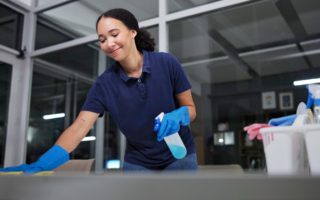
Cleaner, cleaning table woman in office for fumigation, spray disinfect and safety suit from disease risk in building. Maintenance, person and chemical liquid for pest control, health and hygiene
People in the city and the port of Oakland, CA are getting together to think about how to improve local air quality.
It’s a city program that will probably influence other communities to act over time. American communities are getting serious about how to address this problem.
We deal with a wide spectrum of air pollutants every day. Some of these issues are getting worse. Wildfires are just one example. Yes, they destroy homes and take lives, but they also release a lot of potentially harmful particles into the air. Their impact casts a wider net than what some people would think.
In this context, we can learn from what’s happening in those communities. People are more proactively addressing the need for clean air.
What Is Fugitive Dust?
In newspaper coverage of Oakland’s meetings on the issue, you see an interesting word that represents a category of pollutants that locals are trying to decrease.
“Fugitive dust” is kind of what it sounds like. Particles from organic and inorganic materials that get released at places where these materials are disturbed. That could be a construction site, a roadwork project, or some kind of excavation, for example.
The basic idea is that you control the fugitive dust by putting physical safeguards in place during construction or other processes.
“These small dust particles can enter the body and cause heart and lung problems,” writes Callie Rhoades for Oaklandside, a local publication, about work on Oakland’s Community Emissions Reduction Plan. “The question before the group was how to reduce this type of dust and how best to report it to the air district.”
Public Awareness
“Fugitive dust” has a certain ring to it. It catches the eye. Unfortunately, a lot of people don’t know what it means.
Covering the series of meetings where people brainstorm about Oakland‘s project, Rhoades notes that stakeholders tried to figure out how to advertise. They looked at whether they should put something in a newsletter or broadcast it on social media. They also considered using other channels to reach people who don’t understand how fugitive dust impacts their lives.
That’s just one of various sorts of insights that you get reading the press coverage and thinking about what’s actually going on in those rooms. Rhoades notes a lot of the dynamics in the group conversations, without specifically quoting people a whole lot.
Unlikely Partners on Air Quality?
Rhoades mentions that having representatives from the local airport and the nonprofit clean air group made for an “interesting dynamic” because there are lawsuits in play.
Rhoades didn’t quote people on anything they said to each other that was adversarial – but did provide this quote:
“I don’t think this is inevitable,” rebutted Gabrielle Sloan Law, a community steering committee member for the CERP effort, in regard to the airport’s proposed expansion. (Confusingly, “Law” appears to be a part of the individual’s name, and not a designation of legal business position.) “Number one, because there are multiple lawsuits. Number two, because we’re going towards a recession. And number three, because as far as I know the airport has not funded this project.”
Litigation does have a role in some of these processes. But it’s only one part of a bigger picture. We should ask: how do we improve the quality of our air as a whole? That’s important because it is a shared resource. But it really can’t be compartmentalized in the ways that other resources can. Air, in a sense, is everywhere.
Air Quality in Your Home
It’s fairly impossible to control the air quality outside of your house.
However, inside the house where you spend much of your time is another story.
It’s a relatively straightforward process to get an air monitor and use it to see what your indoor air looks like – what’s lurking in your rooms and spaces? How much of those contaminants from outside have made their way in? And what sorts of contaminants are being released from your furniture and things that you bring into your house?
After you’ve answered all these questions, you can install a whole house or floor standing air purifier that will routinely take the air in, run it through a filtration process and other technology, and remove not only fugitive dust, but all kinds of other small things like:
Mold
Dust mites
Formaldehyde
Benzene
Pet dander
The list goes on – And all of this can be accomplished with one machine – a modern powerhouse that hums along in the background, and keeps you and your family in better health.
That’s a pretty compelling reason to get a state of the art air purifier for your home and your workspace. At the same time, we do have to continue to try to improve the outdoor air, as it has a collective effect on everyone. What we shouldn’t do is try to ignore a growing need for clean air and clean water.
Help with Air Purifiers
If you need help shopping for an air purifier, US Air Purifiers LLC can help you with all kinds of questions on design, function, etc. We have a good track record of helping our customers to get the most for their money and get the specific models that they need for their space and situation. You’ll feel better knowing you have this kind of protection in place, in the places where you live and work.